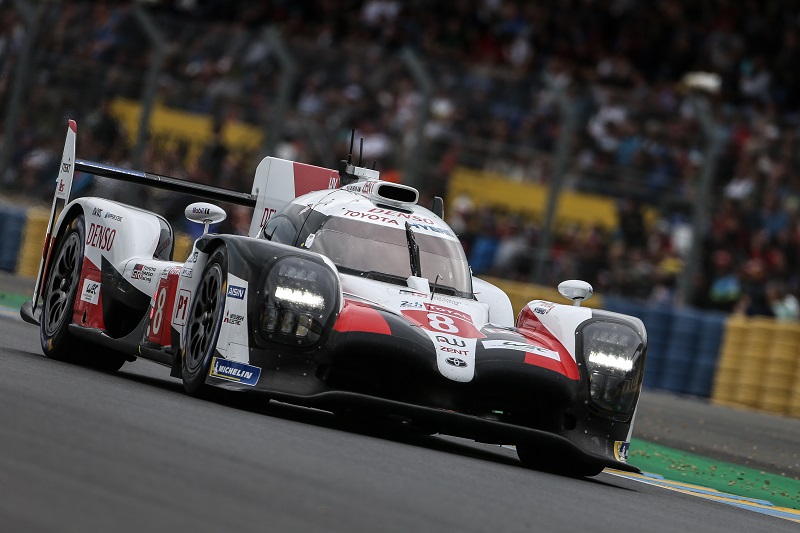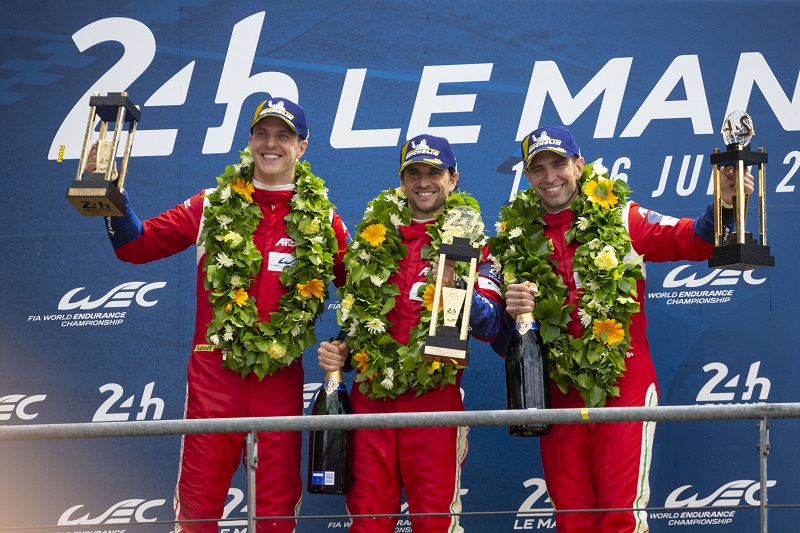
24H Le Mans Analysis: Toyota win back to back Le Mans
It was not the most exciting Le Mans in the race’s in the race’s 96-year history but it had its moments and there was huge drama in the LMP1 class when the leading Toyota #7 suffered a slow puncture with just over an hour to go.
This gifted the win to the #8 Toyota, making Sebastien Buemi, Kazuki Nakajima and Fernando Alonso double Le Mans winners and the 2018/19 LMP1 World Endurance Champions.
LMP2 was won by the #36 Signatech Alpine (Nicolas Lapierre, Andre Nagrao and Pierre Thiriet) having inherited the lead from the #26 G-Drive which would not start under its own power after a pitstop with over six hours to go. The #26 G-Drive lost 15 minutes finding a solution to the problem.
The GTE-Pro class saw frantic action but a little bit of luck saw the #51 AF Corse Ferrari take victory with the #91 and #93 Porsche cars unable to catch the Ferrari in the final hours.
And in GTE-Am, the Keating Motorsport Ford GT took the honours after surviving a late scare when Ben Keating received a stop/go penalty with an hour to go for wheelspinning at his pitstop.
12 cars failed to finish the race whilst the #99 Dempsey-Proton did not even start after Tracey Krohn crashed the car on Wednesday approaching the first chicane on the Mulsanne Straight.
Heartbreak for the #7 Toyota; Conspiracy theories?
The #7 Toyota was the class of the field and had the pace of the sister Toyota car. With over an hour to go, there had been only 10 lead changes in LMP1 (not a lot after 23 hours) as the #7 stretched its lead throughout the race.
Some well-timed safety cars brought the #8 back into play in the middle of the night but ultimately, the #8 never had the ultimate pace and was unable to challenge.
Kamui Kobayashi showed excellent pace to stick the car on pole position, just like he did in 2017 by posting a 3:15.497.
Mike Conway was very fast during the race too and the #7 drivers, including Jose Maria Lopez looked like they were going to walk away with the race.
But, disaster struck as Lopez suffered a slow puncture with 65 minutes remaining. They changed one tyre at the pitstop (but changed the wrong one, apparently due to a sensor problem) so Lopez was forced to limp around the 8.4 miles Circuit de la Sarthe or else the tyre would delaminate and cause suspension and floor damage.
After the Porsche Curves, the #8 flew by and took the lead for the first time in around eight hours.
Conspiracy theories immediately flew in over social media and I did not believe any of it until I heard Toyota only changed one tyre. Why not change all four? Surely, you have to be conservative and change all of the tyres as you are in the lead of one of the greatest and biggest motorsport races of the year.
I think it was a genuine mistake and with hindsight Toyota should have changed all four tyres. Toyota had nothing to gain by ‘staging’ or ‘fixing’ a win for the #8 and the issues for the #7 simply meant the #8 Toyota was there to capitalise on some genuine misfortune and poor race management.
The #7 Toyota winning Le Mans would have meant all six of Toyota’s drivers would have a Le Mans win and Alonso, Buemi and Nakajima would have their world championship. Everyone would be happy.
You could see on the podium that the Toyota drivers (including the winners) were very flat and dejected as they felt like they had not truly won the race. The Toyota #7 led 339 of the 385 laps. Probably similar to how Lewis Hamilton felt after last weekend’s Canadian Grand Prix.
Huge credit must be given to Toyota though as they deserve the win after both cars ran faultlessly for 23 hours and that one slip up meant the #7 did not win the race.

People will say that Toyota had no competition etc. but do not forget that Audi has very little competition until Peugeot came along in 2007. Plus, Toyota have been loyal to the World Endurance Championship; they joined a year earlier than anticipated after Peugeot suddenly left the sport prior to 2012 and saved the LMP1 class for Le Mans that year.
It is also not there fault that Audi and Porsche left to pursue other challenges such as Formula E and the fact that the ACO did not initially put enough input into the privateer LMP1 cars by relying on manufacturers.
Toyota have been mighty and will be looking for a hat-trick in 2020.
The third placed #11 SMP Racing car had a clean race too and did not quite have the pace and lost at least 10 seconds to Toyota after every pitstop (due to the fuel flow). Stoffel Vandoorne drove particularly well and seems to have found a happy place again after two disastrous years in Formula One.
Safety Cars ruin the GTE-Pro battle
The battles in GTE-Pro were on right from the get go and produced the best moments of the race. Five different manufacturers filled the top five qualifying spots.
Aston Martin faded (some might say due to being pegged back after qualifying with BoP) but if you look at their laptimes, they seemed to be good for the first few laps on new tyres and then lost pace as a stint went on.
Corvette, Porsche, Ford and Ferrari were all evenly matched so the BoP (Balance of Performance) was perfect so well done to the ACO. The battling was insane with 4+ car trains going around the circuit, slipstreaming each other and going door to door down the Mulsanne Straight on every other lap.
You could not take your eyes off the action.

Throughout the race, the safety cars split up the GTE-Pro battles. If you don’t know, there are three safety cars at Le Mans (due to the longevity of the circuit) so if a safety car comes out right in the middle of a battle then the cars that are just ahead of it gain a minute as they can push on and catch the next safety car queue whilst the cars that are just behind the safety car have to simply follow the safety car.
Crucially a safety car the GTE-Pro cars at a key moment with three and a half hours to go. The #51 Ferrari gained over a minute because of this and then Jan Magnussen in the #63 Corvette spun (from second place) at the Porsche Curves which all but killed the GTE-Pro battle for the win with the #91 and #93 Porsche cars getting the wrong end of the stick with the safety cars too.
It would have been another classic GTE-Pro finish but it just was not to be in 2019 and Ferrari took their first win in Le Mans top GT class for the first time since 2012. Britain’s James Calado and Italy’s Alessandro Pier Guidi took their first Le Mans wins whilst it was a second GTE-Pro win for Daniel Serra having won with Aston Martin in 2017.
Keating Holds On For a Ford Win
History was made in GTE-Am when the #85 Keating Motorsports Ford GT took the win. Its the first time a privateer Ford has won its class at Le Mans. Tactically, the #85 team decided to run their amateur driver, Ben Keating, at the end with a three hour stint. Keating struggled at night, losing five seconds a lap so the team took him out of the car after one stint to put him back in when there was daylight.
The strategy worked as they built up a lead and Keating held off a charging Jorg Bergmeister in the #56 Team Project 1 Porsche. This was despite a stop/go penalty for Keating for wheelspinning his tyres coming out of a pitstop with an hour to go. A slightly harsh penalty in my opinion as you could hardly see the wheelspin.
Not a Classic, but its Le Mans
The LMP1 did not really deliver a good race and apart from the drama with an hour to go, Toyota were always going to cruise to victory. The GTE-Pro and GTE-Am classes produced some stunning action but even they deflated in action in the final hours after safety cars left chasing cars doing too much to do and leaders in each class having fortune but making the most of it.
But, its Le Mans and it ALWAYS has drama. It may not have been the best Le Mans I have watched (in fact probably one of the worst) but because of the history and because of the tension throughout the race, knowing a key runner will hit trouble at some point, Le Mans will always be special and if 2019 was a bad Le Mans, you know that future Le Mans will be thrillers.



![Private: [ID: 71rYi-xncgM] Youtube Automatic](https://motorradio-xijqc.projectbeta.co.uk/wp-content/uploads/2024/08/private-id-71ryi-xncgm-youtube-a-1-360x203.jpg)
![Private: [ID: 1SfHxvC8Doo] Youtube Automatic](https://motorradio-xijqc.projectbeta.co.uk/wp-content/uploads/2024/07/private-id-1sfhxvc8doo-youtube-a-1.jpg)
![Private: [ID: H6XRkf6kROQ] Youtube Automatic](https://motorradio-xijqc.projectbeta.co.uk/wp-content/uploads/2024/07/private-id-h6xrkf6kroq-youtube-a-1-360x203.jpg)
![Private: [ID: Kb6w-qAmKls] Youtube Automatic](https://motorradio-xijqc.projectbeta.co.uk/wp-content/uploads/2023/12/private-id-kb6w-qamkls-youtube-a-360x203.jpg)
![Private: [ID: CcpwYw20k3k] Youtube Automatic](https://motorradio-xijqc.projectbeta.co.uk/wp-content/uploads/2024/07/private-id-ccpwyw20k3k-youtube-a-360x203.jpg)

![[ID: x1SiRC5jhW4] Youtube Automatic](https://motorradio-xijqc.projectbeta.co.uk/wp-content/uploads/2022/04/id-x1sirc5jhw4-youtube-automatic-360x203.jpg)
![[ID: lMZ8lAeLubk] Youtube Automatic](https://motorradio-xijqc.projectbeta.co.uk/wp-content/uploads/2022/04/id-lmz8laelubk-youtube-automatic-360x203.jpg)
![[ID: GAYCcnqyFo4] Youtube Automatic](https://motorradio-xijqc.projectbeta.co.uk/wp-content/uploads/2022/04/id-gayccnqyfo4-youtube-automatic-360x203.jpg)
![[ID: Gg142H296QY] Youtube Automatic](https://motorradio-xijqc.projectbeta.co.uk/wp-content/uploads/2022/04/id-gg142h296qy-youtube-automatic-360x203.jpg)
![Private: [ID: 71rYi-xncgM] Youtube Automatic](https://motorradio-xijqc.projectbeta.co.uk/wp-content/uploads/2024/08/private-id-71ryi-xncgm-youtube-a-1-236x133.jpg)
![Private: [ID: H6XRkf6kROQ] Youtube Automatic](https://motorradio-xijqc.projectbeta.co.uk/wp-content/uploads/2024/07/private-id-h6xrkf6kroq-youtube-a-1-236x133.jpg)
![Private: [ID: Kb6w-qAmKls] Youtube Automatic](https://motorradio-xijqc.projectbeta.co.uk/wp-content/uploads/2023/12/private-id-kb6w-qamkls-youtube-a-236x133.jpg)
![Private: [ID: nc-8g6ROCe8] Youtube Automatic](https://motorradio-xijqc.projectbeta.co.uk/wp-content/uploads/2023/11/private-id-nc-8g6roce8-youtube-a-236x133.jpg)
![Private: [ID: wWrhfjOQuIc] Youtube Automatic](https://motorradio-xijqc.projectbeta.co.uk/wp-content/uploads/2023/11/private-id-wwrhfjoquic-youtube-a-236x133.jpg)